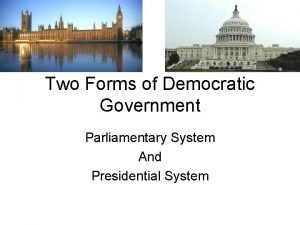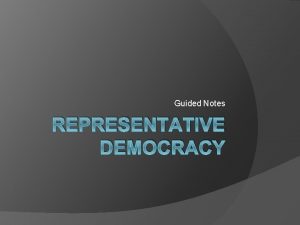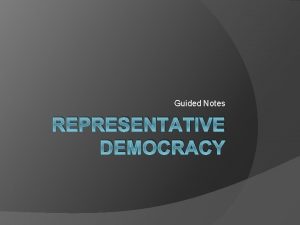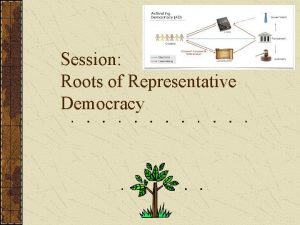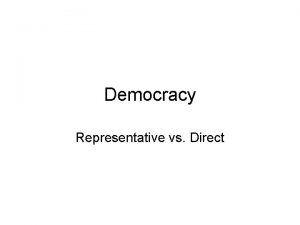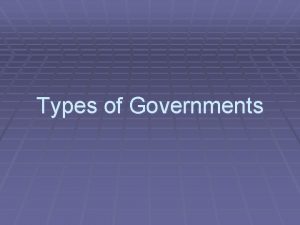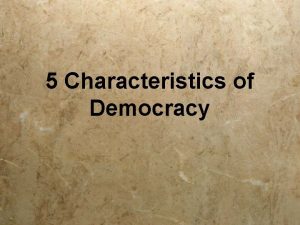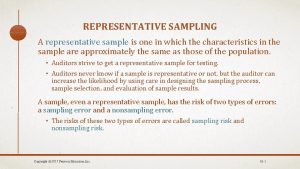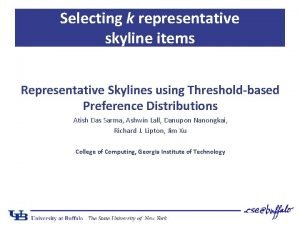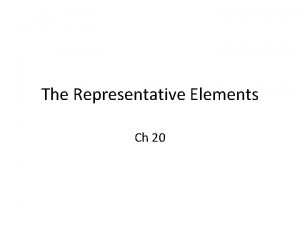Representative Democracy The U S is a representative































- Slides: 31

Representative Democracy

The U. S. is a representative democracy. The representatives form an independent ruling body (for an election period) charged with the responsibility of acting in the people's interest, but not as their proxy representatives not necessarily always according to their wishes, but with enough authority to exercise swift and resolute initiative in the face of changing circumstances. It is often contrasted with direct democracy, where representatives are absent or are limited in power as proxy representatives.

The Legislative Branch of U. S. Government

To ensure a separation of powers, the U. S. Federal Government is made up of three branches: legislative, executive and judicial. To ensure the government is effective and citizens’ rights are protected, each branch has its own powers and responsibilities, including working with the other branches.

The legislative branch is made up of the House and Senate, known collectively as the Congress. Among other powers, the legislative branch makes all laws, declares war, regulates interstate and foreign commerce, and controls taxing and spending policies.

House of Representatives

As per the Constitution, the U. S. House of Representatives makes and passes federal laws. The House is one of Congress’s two chambers (the other is the U. S. Senate), and part of the federal government’s legislative branch. The number of voting representatives in the House is fixed by law at no more than 435, proportionally representing the population of the 50 states.

The major power of the House is to pass federal legislation that affects the entire country, although its bills must also be passed by the Senate and further agreed to by the President before becoming law (unless both the House and Senate re-pass the legislation with a two-thirds majority in each chamber).

The Constitution grants the House several exclusive powers: the power to initiate revenue bills, to impeach officials, and to elect the President in case of an Electoral College deadlock.

Senate

The composition and powers of the Senate are established in Article One of the U. S. Constitution. Each U. S. state is represented by two senators, regardless of population. Senators serve staggered six-year terms. The chamber of the United States Senate is located in the north wing of the Capitol, in Washington, D. C. , the national capital. The House of Representatives convenes in the south wing of the same building.

The Senate has several exclusive powers not granted to the House, including consenting to treaties as a precondition to their ratification and consenting or confirmation of appointments of Cabinet secretaries, federal judges, other federal executive officials, military officers, regulatory officials, ambassadors, and other federal uniformed officers, as well as trial of federal officials impeached by the House.

Senate Roles and Responsibility

The floor leaders and whips of each party are elected by a majority vote of all the Senators of their party assembled in a conference or, as it sometimes is called, a caucus. The practice has been to choose the leader for a two-year term at the beginning of each Congress. The majority and minority leaders are the elected spokespersons on the Senate floor for their respective political parties.

Floor Leaders and Whips Floor leaders - The Majority Leader and Minority Leader are elected by their respective party conferences to serve as the chief Senate spokesmen for their parties and to manage and schedule the legislative and executive business of the Senate. By custom, the Presiding Officer gives the floor leaders priority in obtaining recognition to speak on the floor of the Senate.

Whips Assistants to the floor leaders who are also elected by their party conferences. The Majority and Minority Whips (and their assistants) are responsible for mobilizing votes within their parties on major issues. In the absence of a party floor leader, the whip often serves as acting floor leader.

Committee Subsidiary organization of the Senate established for the purpose of considering legislation, conducting hearings and investigations, or carrying out other assignments as instructed by the parent chamber.

House Roles and Responsibility

House Leadership House leadership includes the speaker, majority and minority leaders, assistant leaders, whips and a party caucus or conference. The speaker acts as leader of the House and combines several institutional and administrative roles. Majority and minority leaders represent their respective parties on the House floor. Whips assist leadership in managing their party's legislative program on the House floor. A party caucus or conference is the name given to a meeting of or organization of all party members in the House. During these meetings, party members discuss matters of concern.

The majority party members and the minority party members meet in separate caucuses to select their leader. Third parties rarely have had enough members to elect their own leadership, and independents will generally join one of the larger party organizations to receive committee assignments.

Representatives Also referred to as a congressman or congresswoman, each representative is elected to a two-year term serving the people of a specific congressional district. Among other duties, representatives introduce bills and resolutions, offer amendments and serve on committees. The number of representatives with full voting rights is 435, a number set by Public Law 62 -5 on August 8, 1911, and in effect since 1913. The number of representatives per state is proportionate to population.

Committees The House’s 20 standing committees have different legislative jurisdictions. Each considers bills and issues and recommends measures for consideration by the House. Committees also have oversight responsibilities to monitor agencies, programs, and activities within their jurisdictions, and in some cases in areas that cut across committee jurisdictions.

Current standing committees of the House: Agriculture; Appropriations; Armed Services; Budget; Commerce; Education and the Workforce; Ethics; Financial Services; Foreign Affairs; Homeland Security; House Administration; Judiciary; Natural Resources; Oversight and Government Reform; Rules; Science, Space, and Technology; Small Business; Transportation and Infrastructure; Veterans’ Affairs; and Ways and Means.

The Committee of the Whole House is a committee of the House on which all representatives serve and which meets in the House Chamber for the consideration of measures from the Union calendar.

Before members are assigned to committees, each committee’s size and the proportion of Republicans to Democrats must be decided by the party leaders. The total number of committee slots allotted to each party is approximately the same as the ratio between majority party and minority party members in the full chamber.






 Elitist democracy ap gov
Elitist democracy ap gov Representative democracy
Representative democracy Political cartoons about democracy
Political cartoons about democracy Direct democracy political cartoon
Direct democracy political cartoon Representative democracy examples
Representative democracy examples Struggle chapter 1
Struggle chapter 1 Parliamentary form of government
Parliamentary form of government Ng-html
Ng-html So nguyen to
So nguyen to Tia chieu sa te
Tia chieu sa te đặc điểm cơ thể của người tối cổ
đặc điểm cơ thể của người tối cổ Các châu lục và đại dương trên thế giới
Các châu lục và đại dương trên thế giới Tư thế worm breton
Tư thế worm breton Thế nào là hệ số cao nhất
Thế nào là hệ số cao nhất Sơ đồ cơ thể người
Sơ đồ cơ thể người ưu thế lai là gì
ưu thế lai là gì Tư thế ngồi viết
Tư thế ngồi viết Bàn tay mà dây bẩn
Bàn tay mà dây bẩn Cách giải mật thư tọa độ
Cách giải mật thư tọa độ Bổ thể
Bổ thể Tư thế ngồi viết
Tư thế ngồi viết Thẻ vin
Thẻ vin Thể thơ truyền thống
Thể thơ truyền thống Các châu lục và đại dương trên thế giới
Các châu lục và đại dương trên thế giới Hát lên người ơi alleluia
Hát lên người ơi alleluia Từ ngữ thể hiện lòng nhân hậu
Từ ngữ thể hiện lòng nhân hậu Sự nuôi và dạy con của hổ
Sự nuôi và dạy con của hổ Diễn thế sinh thái là
Diễn thế sinh thái là Thế nào là giọng cùng tên?
Thế nào là giọng cùng tên? Vẽ hình chiếu vuông góc của vật thể sau
Vẽ hình chiếu vuông góc của vật thể sau Làm thế nào để 102-1=99
Làm thế nào để 102-1=99 Tỉ lệ cơ thể trẻ em
Tỉ lệ cơ thể trẻ em






